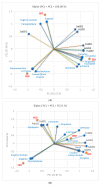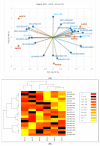Phytochemical Screening and Antibacterial Activity of Commercially Available Essential Oils Combinations with Conventional Antibiotics against Gram-Positive and Gram-Negative Bacteria
- PMID: 38927145
- PMCID: PMC11200707
- DOI: 10.3390/antibiotics13060478
Phytochemical Screening and Antibacterial Activity of Commercially Available Essential Oils Combinations with Conventional Antibiotics against Gram-Positive and Gram-Negative Bacteria
Abstract
The present study aims to evaluate the antibacterial activity of five commercially available essential oils (EOs), Lavender (LEO), Clove (CEO), Oregano (OEO), Eucalyptus (EEO), and Peppermint (PEO), against the most-known MDR Gram-positive and Gram-negative bacteria-Staphylococcus aureus (ATCC 25923), Escherichia coli (ATCC 25922), and Pseudomonas aeruginosa (ATCC 27853)-alone and in various combinations. Gas Chromatography-Mass Spectrometry (GC-MS) analysis established their complex compositions. Then, their antibacterial activity-expressed as the inhibition zone diameter (IZD) value (mm)-was investigated in vitro by the diffusimetric antibiogram method, using sterile cellulose discs with Ø 6 mm impregnated with 10 µL of sample and sterile borosilicate glass cylinders loaded with 100 µL; the minimum inhibitory concentration (MIC) value (µg/mL) for each EO was calculated from the IZD values (mm) measured after 24 h. The following EO combinations were evaluated: OEO+CEO, CEO+EEO, CEO+PEO, LEO+EEO, and EEO+PEO. Then, the influence of each dual combination on the activity of three conventional antibacterial drugs-Neomycin (NEO), Tetracycline (TET), and Bacitracin (BAC)-was investigated. The most active EOs against S. aureus and E. coli were LEO and OEO (IZD = 40 mm). They were followed by CEO and EEO (IZD = 20-27 mm); PEO exhibited the lowest antibacterial activity (IZD = 15-20 mm). EEO alone showed the highest inhibitory activity on P. aeruginosa (IZD = 25-35 mm). It was followed by CEO, LEO, and EEO (IZD = 7-11 mm), while PEO proved no antibacterial action against it (IZD = 0 mm). Only one synergic action was recorded (OEO+CEO against P. aeruginosa); EEO+PEO revealed partial synergism against S. aureus and CEO+PEO showed additive behavior against E. coli. Two triple associations with TET showed partial synergism against E. coli, and the other two (with NEO and TET) evidenced the same behavior against S. aureus; all contained EEO+PEO or CEO+PEO. Most combinations reported indifference. However, numerous cases involved antagonism between the constituents included in the double and triple combinations, and the EOs with the strongest antibacterial activities belonged to the highest antagonistic combinations. A consistent statistical analysis supported our results, showing that the EOs with moderate antibacterial activities could generate combinations with higher inhibitory effects based on synergistic or additive interactions.
Keywords: GC-MS; Gram-positive and Gram-negative bacteria; antibacterial activity; antibacterial drugs; combinations; diffusimetric antibiogram; essential oils; interactions.
Conflict of interest statement
The authors declare no conflicts of interest.
Figures













References
-
- Federal Office of Public Health Which Are the Main Diseases Due to Bacteria? [(accessed on 16 March 2024)]. Available online: https://www.bag.admin.ch/bag/en/home/krankheiten/infektionskrankheiten-b....
-
- Masyita A., Mustika Sari R., Dwi Astuti A., Yasir B., Rahma Rumata N., Emran T.B., Nainu F., Simal-Gandara J. Terpenes and Terpenoids as Main Bioactive Compounds of Essential Oils, Their Roles in Human Health and Potential Application as Natural Food Preservatives. Food Chem. X. 2022;13:100217. doi: 10.1016/j.fochx.2022.100217. - DOI - PMC - PubMed
-
- Aziz Z.A.A., Ahmad A., Setapar S.H.M., Karakucuk A., Azim M.M., Lokhat D., Rafatullah M., Ganash M., Kamal M.A., Ashraf G.M. Essential Oils: Extraction Techniques, Pharmaceutical And Therapeutic Potential—A Review. Curr. Drug Metab. 2018;19:1100–1110. doi: 10.2174/1389200219666180723144850. - DOI - PubMed
Grants and funding
LinkOut - more resources
Full Text Sources
Molecular Biology Databases
Miscellaneous

